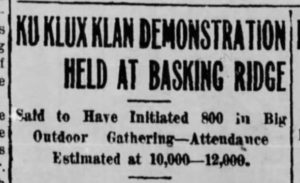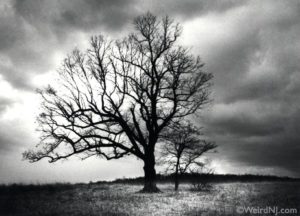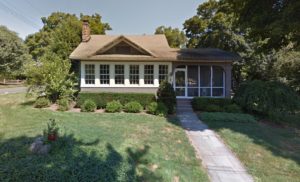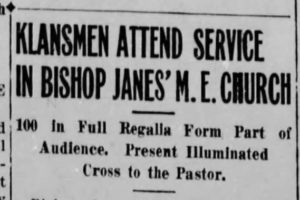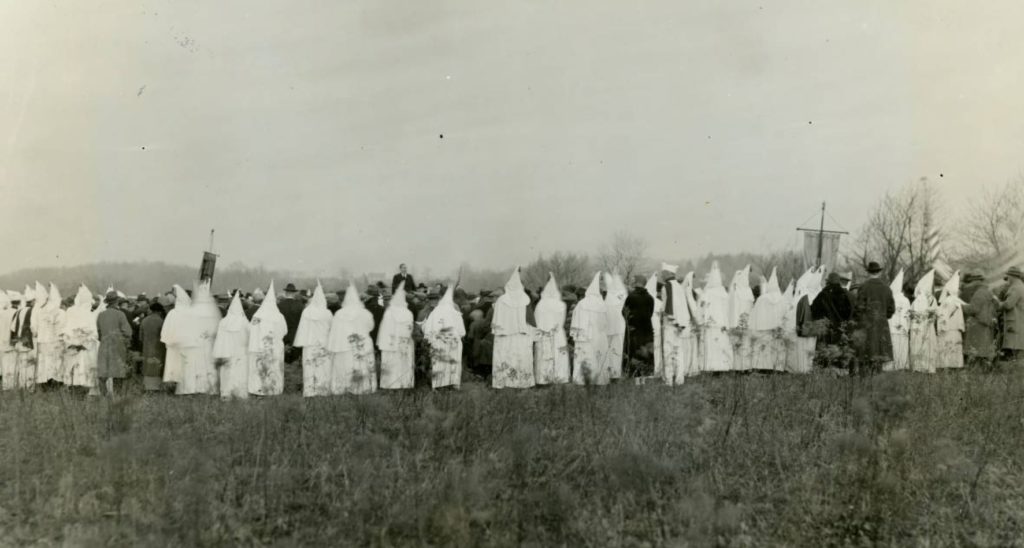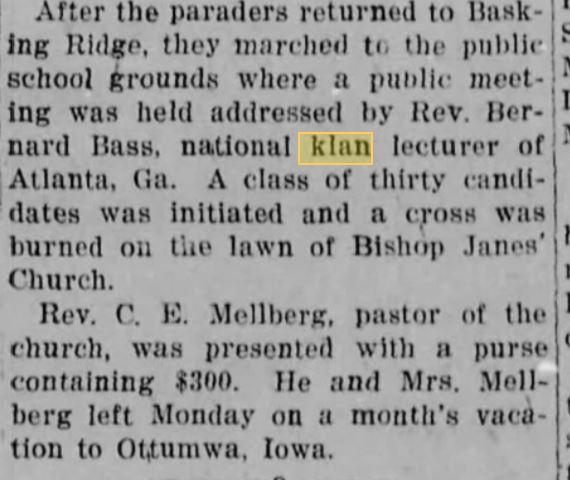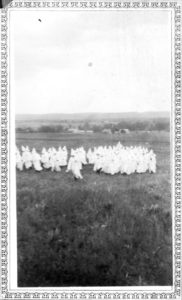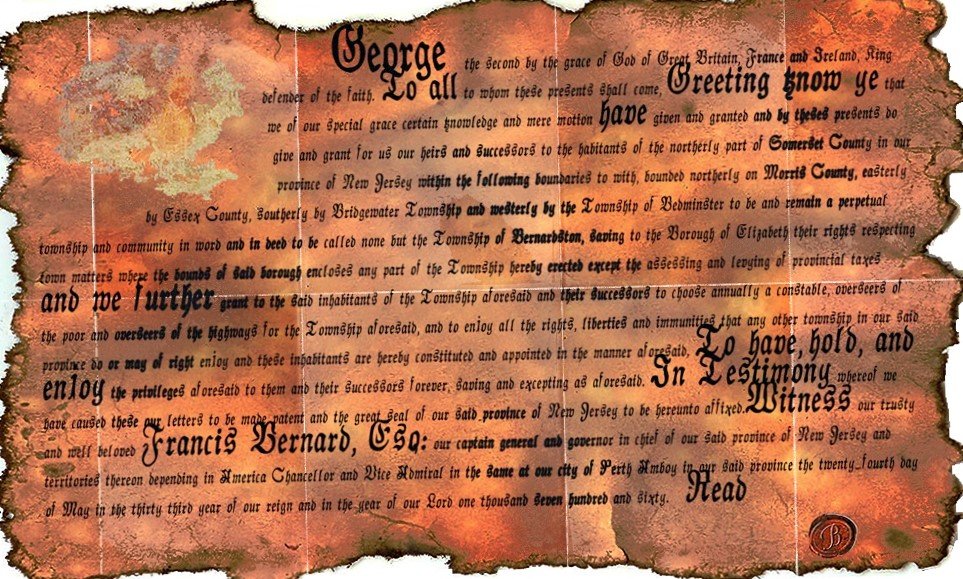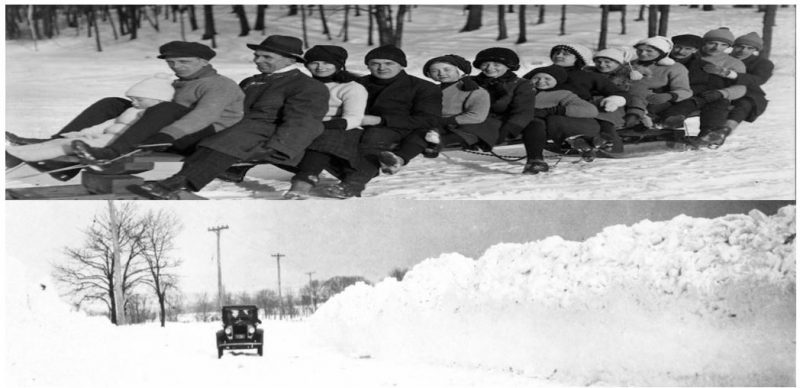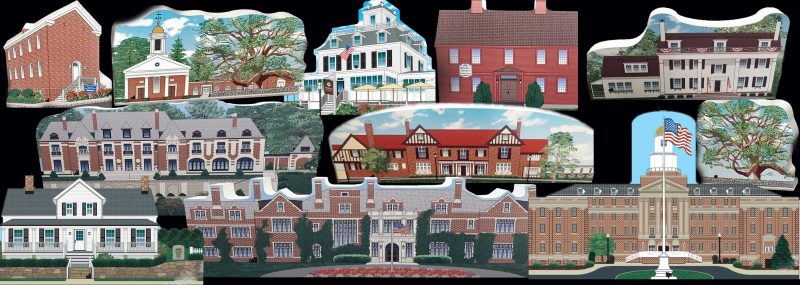NOTE: As with all Mr. Local History retrospectives, we often update the post when we learn stories and are sent photos from our community. We will continue to grow this piece as information becomes available.
History is a strange thing. The myth often outweighs the truth in many cases sometimes distorting the truth just to make a better story. Sometimes it’s like the game where you whisper something to someone, then they whisper to the next and by the tenth person hears the whisper, the story is totally distorted. This article is to shed some light on the facts that are known regarding the Ku Klux Klan in northern Somerset County, New Jersey.
The 1920’s were characterized by profound social change that disturbed many of America’s largely rural, white, Protestant population. They were concerned about the potential power and influence of: African-Americans, southern Europeans, Roman Catholics, Jews, and potential and leftist labor unions. The Klan saw itself as defending American ethics and culture against dangerous foreigners and their ideas. While the group believed that it was defending traditional American values, it often violated some of those values.
On the other hand, one of the major appeals of the Klan in the Somerset Hills was the dual role of being a member. They volunteered to enforce moral codes in their communities and at the same time, symbolize their commitment to God by marching in on church services , in full Klan dress, to leave donations. This is what most likely led to the Klan’s demise in the area and the more prominent race concerned faction of the KKK took over, particularly in the South.
The Research
Before getting started, there’s numerous historic reference materials that highlight klan activity in the area. Trips to the Bernardsville Library history room and The Historical Society of Somerset Hills in Basking Ridge provided information including hand written stories, diaries, photos, and postcards about Klan activity in the area mostly from the 1920’s. The Bernardsville News also had a number of news articles published in the 1920’s and the 1970’s that showcased dates and descriptions, but often left out identifying specific participants. We also searched the Star Ledger as well as Morristown Newspapers.
The Myths
The KKK in the Somerset Hills area runs the gambit on here say and innuendo. The most prevalent topics seem to be about Klan hangings. There have been numerous statements that at ritual gatherings, individuals were hanged at various sites. One rumor is about hangings at the infamous Devil Tree in Liberty Corner. No records, photos, or news stories ever identified a hanging in the 1900’s in the area. There have been statements published about military hangings on the Bernardsville/Basking Ridge boarder during the Revolutionary War, but that’s another topic for another post.
Hangings at the Devil Tree
There is a very evil truth to the mythology of the Devil Tree. At one time, Bernards Township (Basking Ridge/Liberty Corner) had a very large KKK congregation. They held many demonstrations in the town and held many meetings throughout what’s known as the Hills. As per KKK policy, often they would lynch local African-Americans to set an example, not only to other African-Americans, but also as an example of their principles and resolve. There is no truth or stories that substantiate anything Weird New Jersey, or any other publication has posted about Klan hangings. And there is nothing documented regarding killings at the famed Devil Tree. There has been nothing published anywhere we can find about the Klan demonstrating or gathering at the Devil Tree.
Church Organ and KKK Money
Another rumor is that Rev. Carl C. E. Mellburg from the Bishop Janes Methodist church in Basking Ridge took money from Klan membership initiation dues during one of the biggest Klan rallies ever held in the area and donated the money to the Bishop Janes Methodist Church to purchase a new pipe organ.
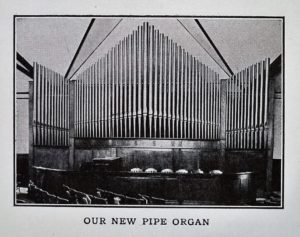
Source: Bishop Janes Methodist Church 1926 program – THSSH Archives
It was rumored at the April 1924 klan gathering, 12,000 klansmen met at the Whitnall property in Basking Ridge and around 800 inductees paid $10 to join the KKK, of which Mellburg received half. The $400 take was very close to the $460 Bishop Janes Methodist Church paid to purchase and install a new organ in 1926.
Grand Kludd’s Master Home
It was also stated that Pastor Mellburg from the Bishop Janes Church in Basking Ridge tried to build a house on the corner of Allen Street and Hillside Terrace, rumored to be three times the price of any house in the neighborhood. It was estimated that the price tag was around $14,000. Based on those assumptions, the biggest house is currently located on 21 E. Allen Street (the NE corner).
With the Klan membership dwindling post 1925 and Mellberg’s various business dealings not panning out, Mellberg was left with his pastor’s income only and couldn’t sustain the project. He went to his father for the money to finish the house. He soon thereafter left the Basking Ridge area and moved to a congregation down in Franklin, New Jersey. We’re not sure what ended up happening with the house, but we’ll keep digging.
The Facts
There is no doubt that there was Klan activity in the Somerset HIlls area between 1920 thru the mid 1920’s before slowly disappearing at the end of the decade. But for those ten years there were some of the largest gatherings ever recorded in New Jersey. Between 1923- 1925 there were three key gatherings that drew between 10,000 to 15,000 klansmen in Basking Ridge. Two points are clear. The rallies were held on the Whitnall property in Basking Ridge, and two churches were involved; the Bishop Janes Methodist Church and the Liberty Corner Presbyterian Church.
A Pastor and a Church
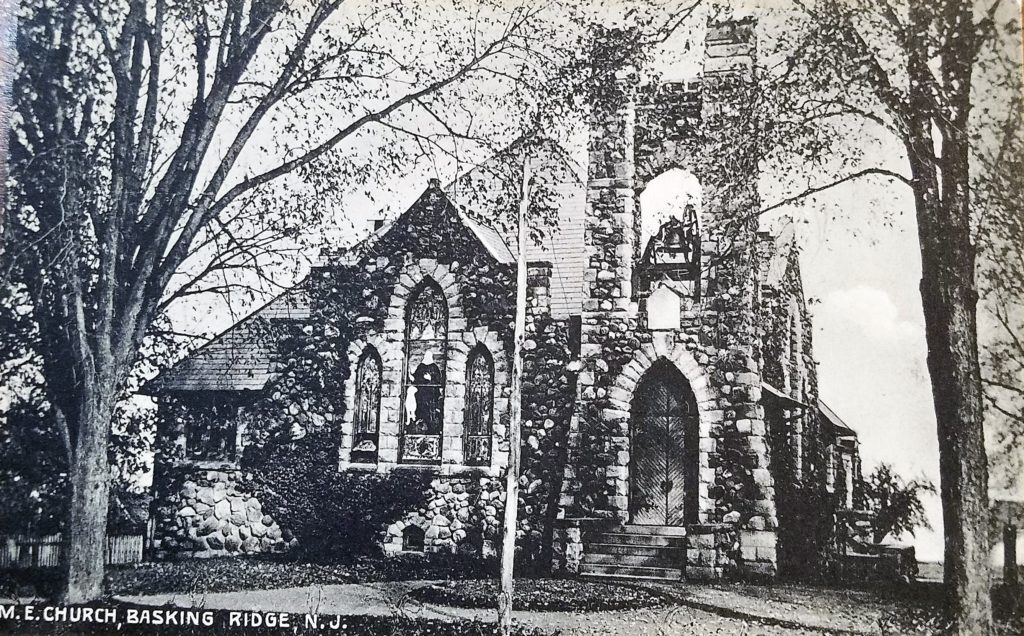
Source: The Historical Society of the Somerset Hills postcard archive
There is a great deal of published information during the 1920’s tying the Bishop Janes Methodist Church and Reverend Carl Mellberg to the Klu Klux Klan in Basking Ridge.
Cover – Bernardsville News Aug. 8 1924 – Klansmen attend service in Bishop Janes Church in Basking Ridge
Reverend Carl Mellberg was appointed the Grand Kludd and served as the area leader for the KKK for 7 years. He was also mentioned as the Kluegel , the Basking Ridge area leader of the KKK. A statement was reported that Reverend Dr. Lauren G. Bennett from the larger Basking Ridge Presbyterian Church was Mellberg’s noted foe “because that church was so powerful and Bennett would not indulge in unnecessary crusading”. At the end of his term, Mellberg stated that he did not like the direction the organization was taking and formally resigned.
On April 5, 1923 ,the Bernardsville News reported that on Prospect Slope Bernardsville a pipe shaped like a cross with inflammable material burned in Bernardsville at 9pm brought firefighters from Bernardsville. Over next few weeks, crosses were burned on Somerset Ave, Bernardsville, the second on M.F Ellis property in Basking Ridge, then on Peapack Road, Far Hills.
The biggest KKK rally to date in the area, was held Saturday, June 23, 1923 on the Whitnall Tract in Basking Ridge, New Jersey. Back then Whitnall Farm covered over 250 acres going from Oak Street south down to Lake Road. When members went under the railroad tracks and they ended on the empty Whitnall tract of land at the top of what is now Spencer Road/Oak Stump Road. The lot went all the way down to Lake Road. Over 1500 cars were noted to be parked on the lot. If you didn’t have the password, dressed Klansmen would not let you pass to the ceremony. It was later noted that 11 crosses were burned up to the Sand Pit Hill.
On Saturday, April 24, 1924 at the Whitnall Farm across from the Evergreen Cemetery Rev. Carl Mellberg of the Bishop Janes Church started the Easter Service for the Klan beginning at 5am. Almost a year to the day, the largest ceremony ever in the area commenced when twenty three fiery crosses were set up in a circle and ignited. Klan attendees were estimated to be between 10,000 to 12,000 with with over 800 inductees awaiting indoctrination. It was estimated that there were 1,500 cars parked on the grounds. The klansmen broke into song, singing “My Country Tis of Thee.” When the song completed, Reverend William D. Amos, pastor for the Liberty Corner Presbyterian Church led in prayer and read a scripture lesson from the twenty-eighth chapter of Matthew. The final song was the hymn “Onward Christian Soldier.”
Since klansmen came from all over the eastern seaboard, when they got to the Somerset Hills Klan organizers sprinkled flour on the roads to direct visitors to the location. If you got into the sector, you were greeted by Klan security who would ask for the appropriate password to enter the Whitnall property. The Whitnall Farm was named after Horatio Gates Whitnall who had been named after the famed Revolutionary War general. Whitnall was Chief Surgeon of the Union army during the Civil War back in 1871. While his tract of land was over 250 acres, Whitnall lived in what’s know as the “sister-house” to the Washington House in Basking Ridge. His home is now the Bank of America building on S. Finley Avenue in Basking Ridge.
On April 17, 1927, Dr. Hiram W. Evans the Imperial Wizard of the KKK, made his first ever appearance in New Jersey in for a rally and Easter service in Basking Ridge. The klan met at Sunrise Hill at 4:00am on the Whitnall Farm on Oak Street across from the Evergreen Cemetery. Dr. Evans made his address at 5:00am at the Bishop Janes Methodist Church where the Easter service was coordinated by the church’s Pastor Carl Mellberg.
It was also noted in the article that the previous year’s service had 863 cars in the village.
It was reported that in West Millington, John V. Haas held picnic of burning crosses, parade, fireworks on a very large farm off present day Haas Road in Bernards Township. It was reported in the Bernardsville News that between 4,000-5,000 attended. The Bernardsville News also reported in 1924 that a rally that was scheduled by Mr. Haas of Basking Ridge was moved to the Liberty Corner Presbyterian Church. What people had to understand is that the LCPC was more conservative than the BRPC so the Klan was very tempting since they promoted strong Christian and family values.
Based on our research, most of the churches took part in the klan events as they saw them as an opportunity to preach American and Christian values. Seeming like it was the right thing to do, a more violent and intimidating klan was also on the rise, mostly in southern states. And this is where the rub began and most likely led to the downfall of the northern klan operations between 1920-1926.
The Kamelia
What was known as the “Kamelia” or the “Ladies of the Invisible Empire”, it was the auxiliary of the KKK for women. There was also a Junior Klan program as well. Both groups were noted marching in a parade on Central Avenue and Main Street in Millington in 1925. The report was that approximately 1,000 people marched in the two groups.
Pastor Carl Mellburg joined the Pillar of Fire Church in Zarapath (pronounced ZARRA-fath) down in Franklin, NJ in either 1925 or 1926. It was stated however in 1927 Mellburg was still the Pastor at the Bishop Janes church in Basking Ridge. The Fire Church in Zarapath played a key role to promoting the Klan The Ku Klux Klan when Alma White published the book In Prophecy.
Bernardsville KKK
Friday Night, Sep. 26, 1924 – 9:45pm – Bernardsville experiences first Klan parade through town. Approximately 50 members marched along with another 40 junior KKK members. The march ended in Basking Ridge. Over 300 cars also participated in the march that ended at the Bishop Janes Methodist Church for a hosted “Fiery Cross Social”.
Peapack KKK
March 24, 1924 – Peapack/Gladstone – Monday night KKK parade then a meeting in the Allen Auditorium in Peapack drawing more than 500 people.
Far Hills KKK
There were also numerous rallies and crosses burned in Far Hills. Below is a photo of a Klan rally in Far Hills c.1920 (Photo courtesy NJDH). There were noted rallies in 1923 burning crosses on the highway near Schley’s Hall in front of the Catholic Rectory.
Bridgewater KKK
The former Rabbit Farm in Bridgewater was purchased by a known area Klansman. The site of the Top of the Hill Tavern was the at the southern portion of what was the former Rabbit Farm which went north up to Brown Road in Bridgewater.
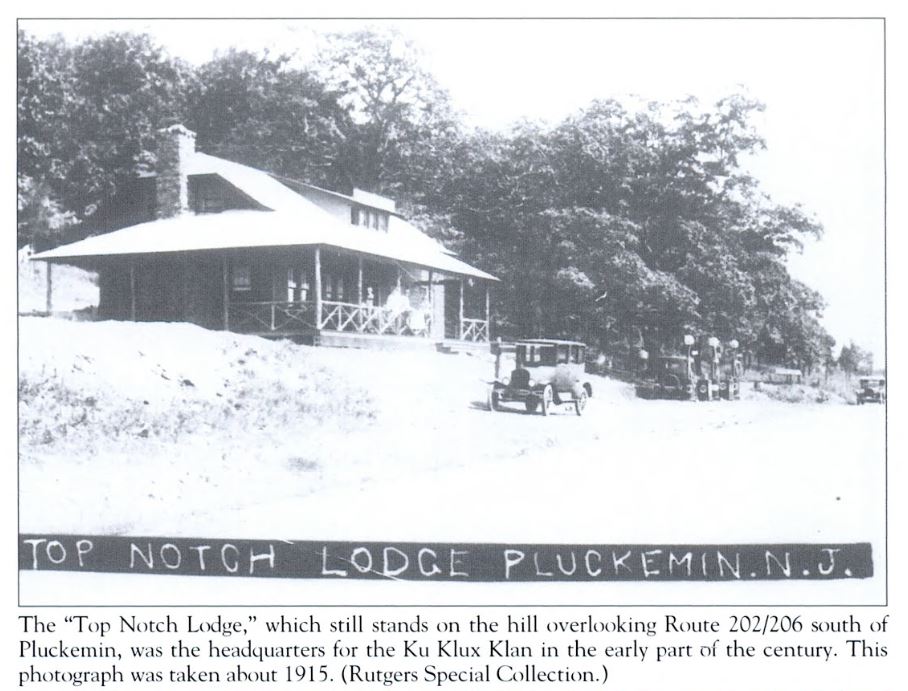
During the 1920’s it was called the Owanamassie Farm Clubhouse on Route 31 in Pluckemin (now Top O’The Hill) . Where the elementary school now stands on Brown Road James Hurley bought the farm in the 1930’s and the property was then broken up and no longer experienced any Klan activity according to Hurley. Two major Easter Rallies were held at sunrise in April 16,1933 at 5:30am and at 5:26am, April 12, 1936. (Bville News – Apr. 9, 1936).
Summary
It’s evident that Basking Ridge, Bernardsville, Far Hills, Peapack, Gladstone and Bridgewater were KKK hotbeds in the 1920’s. Based on the written records there was never any mention of hangings, forced lynchings, or Klan murders in any of the stories. So when you hear that the Klan murdered people at the Devil Tree, or at Top of the Hill, or at the Sand Hill, the facts just don’t show that happened. Just as quickly as the organization started in the area, by the time the Great Depression hit, it was all but a trace.
Still Under Investigation
- April 14, 1925 Rally
What do you know?
Facts often do show up in this new digital age. While there isn’t anyone still alive from the 1920’s, there might be stories, images, artifacts that come to light. If you have something to share, post a comment or reach out to our editorial team.
